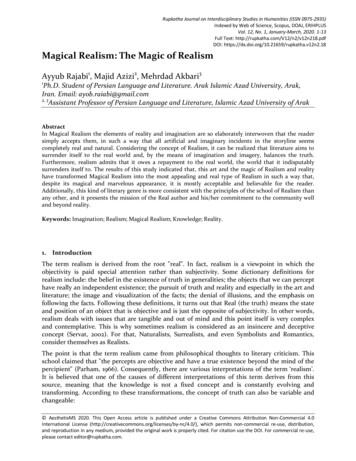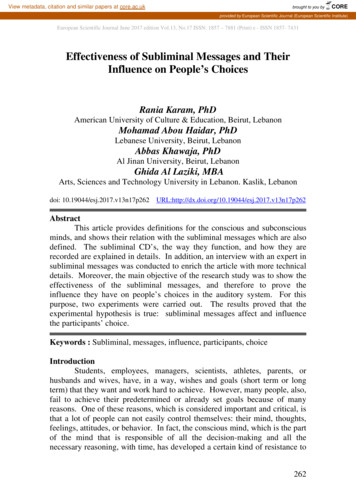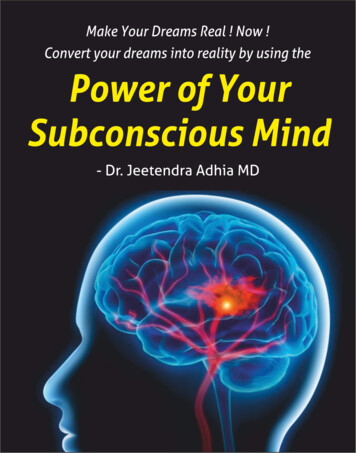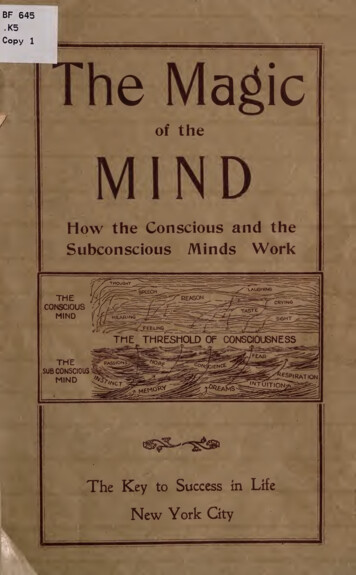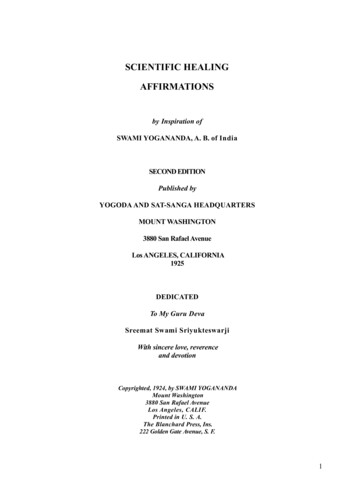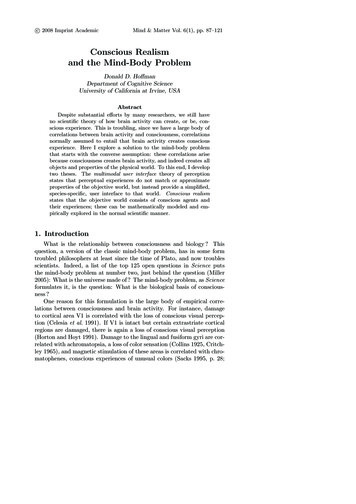
Transcription
c 2008 Imprint Academic Mind & Matter Vol. 6(1), pp. 87–121Conscious Realismand the Mind-Body ProblemDonald D. HoffmanDepartment of Cognitive ScienceUniversity of California at Irvine, USAAbstractDespite substantial efforts by many researchers, we still haveno scientific theory of how brain activity can create, or be, conscious experience. This is troubling, since we have a large body ofcorrelations between brain activity and consciousness, correlationsnormally assumed to entail that brain activity creates consciousexperience. Here I explore a solution to the mind-body problemthat starts with the converse assumption: these correlations arisebecause consciousness creates brain activity, and indeed creates allobjects and properties of the physical world. To this end, I developtwo theses. The multimodal user interface theory of perceptionstates that perceptual experiences do not match or approximateproperties of the objective world, but instead provide a simplified,species-specific, user interface to that world. Conscious realismstates that the objective world consists of conscious agents andtheir experiences; these can be mathematically modeled and empirically explored in the normal scientific manner.1. IntroductionWhat is the relationship between consciousness and biology ? Thisquestion, a version of the classic mind-body problem, has in some formtroubled philosophers at least since the time of Plato, and now troublesscientists. Indeed, a list of the top 125 open questions in Science putsthe mind-body problem at number two, just behind the question (Miller2005): What is the universe made of ? The mind-body problem, as Scienceformulates it, is the question: What is the biological basis of consciousness ?One reason for this formulation is the large body of empirical correlations between consciousness and brain activity. For instance, damageto cortical area V1 is correlated with the loss of conscious visual perception (Celesia et al. 1991). If V1 is intact but certain extrastriate corticalregions are damaged, there is again a loss of conscious visual perception(Horton and Hoyt 1991). Damage to the lingual and fusiform gyri are correlated with achromatopsia, a loss of color sensation (Collins 1925, Critchley 1965), and magnetic stimulation of these areas is correlated with chromatophenes, conscious experiences of unusual colors (Sacks 1995, p. 28;
88HoffmanZeki 1993, p. 279). Damage to area V5 is correlated with akinetopsia, aloss of motion sensation (Zihl et al. 1983, 1991; Rizzo et al. 1995); magnetic inhibition of V5 is also correlated with akinetopsia (Zeki et al. 1991).In many tasks in which subjects view a display inducing binocular rivalry,so that they consciously perceive the stimulus presented to one eye andthen periodically switch to consciously perceive the stimulus presented tothe other eye, there are changes in cortical activity precisely correlatedwith changes in conscious perception (Alais and Blake 2004), changes thatcan be measured with fMRI (Lumer et al. 1998, Tong et al. 1998), EEG(Brown and Norcia 1997), MEG (Tononi et al. 1998), and single unitrecording (Leopold and Logothetis 1996). Such correlated activity canbe found in ventral extrastriate, parietal, and prefrontal cortices (Rees etal. 2002).Such correlations, and many more not mentioned here, persuade mostresearchers that brain activity causes, or is somehow the basis for, consciousness. As Edelman (2004, p. 5) puts it: “There is now a vast amountof empirical evidence to support the idea that consciousness emerges fromthe organization and operation of the brain.” Similarly, Koch (2004,pp. 1–2) argues:The fundamental question at the heart of the mind-body problemis, what is the relation between the conscious mind and the electrochemical interactions in the body that give rise to it ? How do[conscious experiences] emerge from networks of neurons ?Consensus on this point shapes the current scientific statement of themind-body problem. It is not the neutral statement that opened thissection, viz.: What is the relationship between consciousness and biology ? Instead, as Science makes clear, it is a statement that indicates theexpected nature of the solution: What is the biological basis of consciousness ? Given this consensus, one would expect that there are promisingtheories about the biological basis of consciousness, and that research isproceeding to cull and refine them. Indeed such theories are numerous,both philosophical and scientific, and the volume of empirical work, brieflyhighlighted above, is large and growing.For instance, following the demise of behaviorism in the 1950s, therehave been many philosophical theories. Type physicalist theories assert that mental state types are numerically identical to certain neuralstate types (Place 1956, Smart 1959); token physicalist theories assertinstead that each mental state token is numerically identical to some neural state token (Fodor 1974). Reductive functionalist theories assert thatthe type identity conditions for mental states refer only to relations, typically causal relations, between inputs, outputs, and each other (Blockand Fodor 1972). Non-reductive functionalist theories make the weakerclaim that functional relations between inputs, outputs and internal sys-
Conscious Realism and the Mind-Body Problem89tem states give rise to mental states but are not identical with such states(Chalmers 1996). Representationalist theories (e.g., Tye 1996, 2000) identify conscious experiences with certain tracking relationships, i.e., withcertain causal covariations, between brain states and states of the physical world. The “biological naturalism” theory of Searle (1992, 2004)claims that consciousness can be causally reduced to neural processes,but cannot be eliminated and replaced by neural processes.This brief overview does not, of course, begin to explore these theories, and it omits important positions, such as the emergentism of Broad(1925), the anomalous monism of Davidson (1970), and the superveniencetheory of Kim (1993). However it is adequate to make one obvious point.The philosophical theories of the mind-body problem are, as they advertise, philosophical and not scientific. They explore the conceptual possibilities where one might eventually formulate a scientific theory, but theydo not themselves formulate scientific theories. The token identity theories, for instance, do not state precisely which neural state tokens areidentical to which mental state tokens. The non-reductive functionalisttheories do not state precisely which functional relations give rise, say, tothe smell of garlic versus the smell of a rose, and do not give principledreasons why, reasons that lead to novel, quantitative predictions. Thesecomments are not, of course, intended as criticisms of these theories, butsimply as observations about their intended scope and limits.It is from the scientists that we expect theories that go beyond statements of conceptual possibilities, theories that predict, from first principles and with quantitative precision, which neural activities or whichfunctional relations cause which conscious experiences. Scientists haveproduced several theories of consciousness.For instance, Crick and Koch (1990, cf. Crick 1994) proposed that certain 35-75 Hz neural oscillations in cerebral cortex are the biological basisof consciousness. Subsequently Crick and Koch (2005) proposed that theclaustrum may be responsible for the unified nature of conscious experience. Edelman and Tononi (2000, p. 144; cf. Tononi and Sporns 2003)proposed that “a group of neurons can contribute directly to conscious experience only if it is part of a distributed functional cluster that, throughreentrant interactions in the thalamocortical system, achieves high integration in hundreds of milliseconds.” Baars (1988) proposed that consciousness arises from the contents of a global workspace, a sort of blackboard by which various unconscious processors communicate informationto the rest of the system. Hameroff and Penrose (1996, cf. Penrose 1994)proposed that quantum coherence and quantum-gravity-induced collapsesof wave functions are essential for consciousness. Stapp (1993, 1996) proposed that the brain evolves a superposition of action templates, and thecollapse of this superposition gives rise to conscious experience.Again, this brief overview does not begin to explore these theories
90Hoffmanand, for brevity, omits some. But the pattern that emerges is clear. Thetheories so far proposed by scientists are, at best, hints about where tolook for a genuine scientific theory. None of them remotely approaches theminimal explanatory power, quantitative precision, and novel predictivecapacity expected from a genuine scientific theory. We would expect, forinstance, that such a theory could explain, in principle, the difference inexperience between, e.g., the smell of a rose and the taste of garlic. How,precisely, is the smell of a rose generated by a 40 Hz oscillation, a reentrantthalamocortical circuit, information integration, a global-workspace entry,the quantum state of microtubules, or the collapse of evolving templates ?What precise changes in these would transform experience from the smellof a rose to the taste of garlic ? What quantitative principles accountfor such transformations ? We are not asking about advanced features ofconsciousness, such as self-consciousness, that are perhaps available to fewspecies. We are asking about an elementary feature available, presumably,to a rat. But no current theory has tools to answer these questions andnone gives guidance to build such tools. None begins to dispel the mysteryof conscious experience. As Pinker (1997, p. 564) points out, “. . . howa red-sensitive neuron gives rise to the subjective feel of redness is nota whit less mysterious than how the whole brain gives rise to the entirestream of consciousness.”In short, the scientific study of consciousness is in the embarrassingposition of having no scientific theory of consciousness. This remarkablesituation provokes several responses. The first concludes that, althoughconsciousness arises naturalistically from brain activity, humans lack thecognitive capacities required to formulate a scientific theory. As McGinn(1989) puts it, “we know that brains are the de facto causal basis of consciousness, but we have, it seems, no understanding whatever of how thiscan be so.” Pinker (1997) agrees. After asking how conscious experiencearises from physical systems he answers (Pinker 1997, pp. 146–147):Beats the heck out of me. I have some prejudices, but no idea ofhow to begin to look for a defensible answer. And neither doesanyone else. The computational theory of mind offers no insight;neither does any finding in neuroscience, once you clear up the usualconfusion of sentience with access and self-knowledge.A second response concludes that we must keep experimenting untilwe find the empirical fact that leads to a theoretical breakthrough. Thisis a defensible position and, indeed, the position of most researchers inthe field.A third response claims there is no mind-body problem, on at leasttwo different grounds: There is no mind to reduce to body, or no body towhich mind can be reduced. The first of these two arguments is sometimesasserted by eliminative materialists, who claim that nothing in reality cor-
Conscious Realism and the Mind-Body Problem91responds to our folk psychological notions of consciousness (Churchland1981, Churchland 1986, Dennett 1978). As neuroscience progresses wewill not reduce such notions to neural activity; we will abandon them,much as we abandoned phlogiston. We will instead adopt the language ofneurophysiology.The second argument, that there is no body to which mind can bereduced, is made most notably by Chomsky (1980, 2000), who arguesthat there has been no coherent formulation of the mind-body problemsince Newton introduced action-at-a-distance and, thereby, destroyed anyprincipled demarcation between the physical and non-physical. Chomskyconcludes that consciousness is a property of organized matter, no morereducible than rocks or electromagnetism (Chomsky 2000, p. 86). However, what counts as matter is no clearer than what counts as physical.And why should we expect, in the non-dualistic setting that Chomsky endorses, that consciousness is a property of matter rather than vice versa ?This is a natural point of departure for the theory developed here. Thedualistic formulation of the mind-body problem, in which consciousnessarises from non-conscious neurobiology or physics, has failed to producea scientific theory. But the search space of scientific theories is large, andit is reasonable, given the failure of explorations in the dualistic region,to explore elsewhere. That is the intent here: to explore a non-dualistic,but mathematically rigorous, theory of the mind-body problem, one thatdoes not assume consciousness is a property of organized matter. To thisend, we first develop a non-dualistic theory of perception that questionsa key assumption of current perceptual theories.2. Perception as Faithful DepictionCurrent scientific theories of perception fall into two main classes:direct and indirect (see, e.g., Fodor and Pylyshyn 1981, Hoffman 1998,Palmer 1999).Indirect theories, which trace their lineage through Helmholtz (1910/1962) and Alhazen (956–1039; cf. Sabra 1978), typically claim that a goalof perception is to match, or at least approximate, useful properties of anobjective physical world (Marr 1982). The physical world is taken to beobjective in the sense that it does not depend on the perceiver for its existence. According to indirect theories, the information transduced at sensory receptors is not sufficiently rich, by itself, to determine a unique andcorrect match or approximation. Therefore the perceiver must infer properties of the world using constraining assumptions. For instance, in theperception of a three-dimensional shape from visual motion, the perceivermight use a rigidity assumption: If the image data could have arisen, inprinciple, by projection of the motion of a rigid three-dimensional body,
92Hoffmanthen the visual system infers that the image data are, in fact, the projection of that rigid body (Ullman 1979). This inference might be couched inthe mathematical framework of regularization theory (Poggio et al. 1985)or Bayesian inference (Knill and Richards 1996).Direct theories, which trace their origin to Gibson (1950, 1966, 1979/1986), agree with indirect theories that a goal of perception is to match anobjective physical world, but argue that the sensory data are sufficientlyrich that perceivers can, without inference, pick up true properties of theworld, especially affordances, directly from these data.The debate between direct and indirect theories raises interesting issues (Fodor and Pylyshyn 1981, Ullman 1980). But what is pertinent hereis that both agree on this: A goal of perception is to match or approximatetrue properties of an objective physical environment. We can call this thehypothesis of faithful depiction (HFD). This hypothesis is widespread andrarely questioned in the scientific study of perception.For instance, Stoffregen and Bardy (2001) state:We analyze three hypotheses about relations between ambient arrays and physical reality: (1) that there is an ambiguous relationbetween ambient energy arrays and physical reality, (2) that thereis a unique relation between individual energy arrays and physicalreality, and (3) that there is a redundant but unambiguous relation,within or across arrays, between energy arrays and physical reality.The first hypothesis is endorsed by indirect theories, and the second bysome direct theories. They conclude in favor of the third hypothesis,viewing it as an extension of standard direct theories. Nowhere do theyquestion the assumption of faithful depiction that is shared by all three;nor do any of the more than 30 commentaries on their article.Yuille and Buelthoff (1996, p. 123) endorse HFD: “We define visionas perceptual inference, the estimation of scene properties from an image or sequence of images.” The commitment to HFD is clear in suchterms as ‘estimate’, ‘recover’, and ‘reconstruct’, which appear repeatedlythroughout the literature of computational vision.Lehar (2003, p. 375) endorses HFD: “The perceptual modeling approach reveals the primary function of perception as that of generatinga fully spatial virtual-reality replica of the external world in an internalrepresentation.”Searle (2004, p. 171) endorses HFD: “In visual perception, for example, if I see that the cat is on the mat, I see how things really are (andthus achieve mind-to-world direction of fit) only if the cat’s being on themat causes me to see the situation that way (world-to-mind direction ofcausation).”Purves and Lotto (2003) appear, on first reading, to reject HFD. Theyreject, for instance, “the seemingly sensible idea that the purpose of vision
Conscious Realism and the Mind-Body Problem93is to perceive the world as it is. . . ” (p. 5). They suggest instead that(p. 287)what observers actually experience in response to any visual stimulus is its accumulated statistical meaning (i.e., what the stimulushas turned out to signify in the past) rather than the structure ofthe stimulus in the image plane or its actual source in the present.Thus Purves and Lotto do not, in fact, recommend rejection of HFD toutcourt. They simply recommend rejecting a version of the hypothesis thatfocuses exclusively on the present stimulus and the present state of thephysical world. The purpose of vision is to perceive the world, not just asit is, but as it has been.Noë and Regan (2002) also appear, on first reading, to reject HFD.They reject, for instance, the position that “. . . the visual system buildsup a detailed internal representation of the three-dimensional environment on the basis of successive snapshot-like fixations of the scene . . . ”(p. 575). They propose instead that “what one sees is the aspect of thescene to which one is attending – with which one is currently interacting. . . ” (p. 575). Thus Noë and Regan also do not reject HFD tout court.They claim that “perceivers are right to take themselves to have accessto environmental detail and to learn that the environment is detailed”(p. 576) and that “the environmental detail is present, lodged, as it is,right there before individuals and that they therefore have access to thatdetail by the mere movement of their eyes or bodies” (p. 578). Thus theysupport a version of HFD that is careful to observe the limits of perceptualattention and the critical role of sensorimotor interactions.HFD is so universally accepted that it appears in textbooks. Forinstance, Palmer (1999, p. 6, his italics) endorses HFD as follows:Evolutionarily speaking, visual perception is useful only if it is reasonably accurate . . . Indeed, vision is useful precisely because it isso accurate. By and large, what you see is what you get. When thisis true, we have what is called veridical perception . . . perceptionthat is consistent with the actual state of affairs in the environment.This is almost always the case with vision. . .I, too, endorsed HFD, describing the central questions about visualperception as follows (Hoffman 1983, p. 154): “First, why does the visualsystem need to organize and interpret the images formed on the retinas ?Second, how does it remain true to the real world in the process ? Third,what rules of inference does it follow ?” But I now think HFD is false.Our perceptual systems do not try to approximate properties of an objective physical world. Moreover evolutionary considerations, properlyunderstood, do not support HFD, but require its rejection.I propose that perception is like a multimodal user interface (Hoffman1998, 2003). A successful user interface does not, in general, resemble
94Hoffmanwhat it represents. Instead it dumbs down and reformats in a manneruseful to the user. Because it simplifies, rather than resembles, a user interface usefully and swiftly informs the actions of the user. The featuresin an interface usually differ from those in the represented domain, withno loss of effectiveness. A perceptual user interface, simplifying and reformatting for the niche of an organism, gives that organism an adaptiveadvantage over one encumbered with constructing a complex approximation to the objective world. The race is to the swift; a user interface makesone swift by not resembling the world.This is not what textbooks or most perceptual experts say and therefore invites spelling out. I begin by discussing user interfaces and virtualworlds.3. User InterfacesSuppose you wish to delete a file on your PC. You find the icon for thefile, click on it with your mouse, drag it to the recycle-bin icon, and release.Quick and easy. The file icon might be blue and square. The recycle binmight be shaped like a trash can. All for ease of use. Of course whatgoes on behind the icons is quite complex: A central processor containingmillions of transistors executes binary commands encoded as voltages inmegabytes of memory, and directs the head on a hard drive to changethe magnetic structure of a disk revolving thousands of times per minute.Fortunately, to delete a file you do not need to know anything about thiscomplexity. You just need to know how to move colorful icons.The icons, and the entire graphical-windows interface, are designed tohelp the user by hiding the complexity of the computer (see, e.g., Schneiderman 1998). This is accomplished, in part, by friendly formatting. Thewindows interface and its contents are designed not to resemble the actualcomplexity of the computer and its inner workings, but instead to presentneeded information to the user in a format that is friendly, i.e., that is easyand natural to use. Although the actual file in the computer is a complexarray of voltages and magnetic fields with no simple geometry, the file iconis a rectangle because this is a simple symbol easily interpreted by humanusers. Nothing about the shape of the file icon resembles the shape of thefile itself. This is no failure of the icon, no misrepresentation of reality. Itis, instead, what makes the icon useful.Few souls delight to search the guts of a computer with voltmeter andmagnetometer to find a file. We prefer to find a rectangular blue icon in apretty display. But nothing about the file itself, the voltages and magneticfields inside the computer, is blue. Is this a gross misrepresentation bythe icon ? Of course not. The color of the icon is not intended to resembleanything about the file but simply to indicate, say, what kind of file it
Conscious Realism and the Mind-Body Problem95is or how recently it was modified. The icon sits at some spot on thedisplay, perhaps in the upper right. But this does not mean that the fileitself is in the upper right of the computer. The location of an icon onthe display is, in part, simply a convenient way to keep track of it. Thereis, in short, no resemblance between properties of the icon and propertiesof the file. This is no problem, no failure of veridicality. It is the intendedconsequence of friendly formatting.The interface also helps the user by means of concealed causality. Notonly is the structural complexity of the computer hidden behind icons,but also its causal complexity. When you drag the file icon to the recyclebin and release, does moving the file icon to the recycle bin icon causedeletion of the file ? No. Icons have no causal powers within the computer.They are patterns of pixels on the display, and send no signals back tothe computer. The complex causal chain within the computer that deletesthe file is hidden, behind the interface, from the user. And nothing in themovement of the file icon to the recycle-bin icon resembles anything in thiscausal chain. Is this a failure or misrepresentation of the interface ? Tothe contrary, it is the reason for the interface. Hiding causal complexityhelps the user to quickly and easily delete a file, create a new one, modifyan illustration, or format a disk, without distraction by a myriad of causaldetails.Although the icons of the interface have no causal powers they arenonetheless useful by providing clued conduct. The icons effectively inform actions of the user, allowing the user to trigger the appropriate, buthidden, causal chains.1 In the case of deleting a file, the icon of the fileinforms the user how to click the mouse, and the icon of the recycle bininforms the user how to release the mouse, so that appropriate causalchains are triggered inside the computer, resulting in deletion of the file.Icons inform an effective perception-action loop, without themselves having causal powers in the computer.To the extent that a user interface succeeds in providing friendly formatting, concealed causality, and clued conduct, it will also offer ostensibleobjectivity. Usually the user can act as if the interface is the total reality ofthe computer. Indeed some users are fooled; we hear humorous stories ofa child or grandparent who wondered why an unwieldy box was attachedto the screen. Only for more sophisticated purposes, such as debugginga program or repairing hardware, does dissolution of this illusion becomeessential.1 Here, and throughout the paper, the verb trigger means “to initiate a sequence ofactions, typically causal and complex.” To say, for instance, that stress triggers cardiovascular disease means that stress initiates a complex causal sequence of biochemicalinteractions that eventuate in the disease.
96Hoffman4. Virtual WorldsSuppose you and a friend play virtual tennis at an arcade. You donyour helmet and bodysuit, and find yourself in Roland-Garros stadium,home of the French Open. After admiring the clay court and stadium, youserve to open the first set, and are soon immersed in play. The stadium,court, net, ball, and racquet that you experience are all, of course, part of asophisticated user interface, one that exhibits the four qualities describedin the last section. First, it sports friendly formatting. You see red clay,a yellow ball, a graphite tennis racquet, and a green stadium. These aremuch easier to interpret and use than the complex supercomputer andmegabytes of software that control the game.It conceals causality and clues conduct. When you hit a killer dropvolley, it might appear that the head of the racquet caused the ball tosneak across the net. But of course the racquet and ball are just pixels inthe user interface, and send no signals back to the supercomputer. Theracquet and ball serve only to inform your actions and these, transmitted back via the body suit, trigger a complex but hidden causal sequencewithin the supercomputer, resulting in the proper updating of registerscorresponding to the positions of racquet and ball. A good programmercould update these registers directly. But this would be so slow and cumbersome that even the deftest coder would lose the match to a modestlytalented player who simply acted on the user interface. That is the power,and purpose, of the interface.Finally, the commercial success of the game depends, in large part,on its ostensible objectivity. Customers want to play tennis, blissfullyignorant of the supercomputer and software hard at work in a back room.Tennis is, for them, the reality. Nothing in their tennis reality resemblesthe hidden supercomputer, the true causal nexus that makes the gamepossible. Customers can play as if the tennis ball and racquet had causalpowers, even though this is merely a convenient, and entertaining, fiction.5. Perception as a Multimodal User InterfaceI reject HFD, the hypothesis that a goal of perception is to match orapproximate properties of an objective physical world. Instead I proposethe hypothesis of multimode user interfaces (MUI): The conscious perceptual experiences of an agent are a multimodal user interface between thatagent and an objective world.To say that a world is objective means that the world’s existence doesnot depend on the agent. MUI theory claims nothing about the ontologyof that objective world. It requires no resemblance between propertiesof the interface and the world. As virtual tennis illustrates, they canbe as dissimilar as tennis balls and integrated circuits. MUI is a weaker
Conscious Realism and the Mind-Body Problem97hypothesis than HFD: Both say perception represents an objective world;but HFD claims, in addition, that perception resembles that objectiveworld. MUI theory makes no such claim.For instance, if you experience a rock or tree, HFD claims that, barring illusion, there must be a rock or tree in the objective world whoseproperties approximate those of your experience. MUI theory is not committed to this claim. It allows countless possibilities for what in theobjective world triggered your experience. Chances are there is no matchbetween properties of experience and the objective world. Instead perceptual experiences are, in the typical case, much less complex and differentlyformatted than the objective properties that trigger them. This failureto match, due to adaptive simplification and reformatting, is key to theusefulness of perceptual experiences. Concern about veridicality of perception is a category error. The proper concern is whether perceptionusefully informs action.According to MUI theory, the objects of everyday experience – tables,chairs, mountains, moon – are not public. If, for instance, I hand you aglass of water, it is natural, but false, to assume that the glass I once heldis the same glass you now hold. Instead, according to MUI theory, theglass I held was, when I observed it, an icon of my MUI, and the glassyou now hold is, when you observe it, an icon of your MUI, and they arenumerically distinct. There are two glasses of water, not one. And if athird person watches the transaction, there are three glasses.This claim seems, to most, absurd,
c 2008 Imprint Academic Mind & Matter Vol. 6(1), pp. 87-121 Conscious Realism and the Mind-Body Problem Donald D. Hoffman Department of Cognitive Science University of California at Irvine, USA Abstract Despite substantial efforts by many researchers, we still have no scientific theory of how brain activity can create, or be, con-scious .


